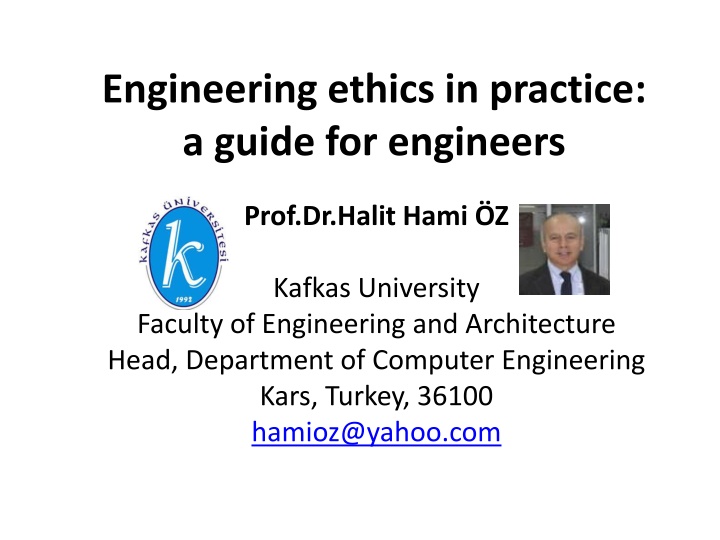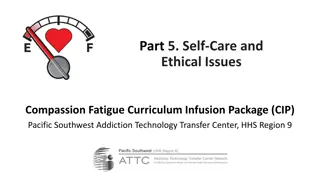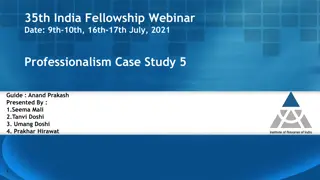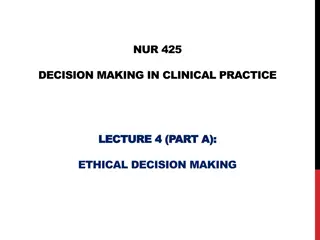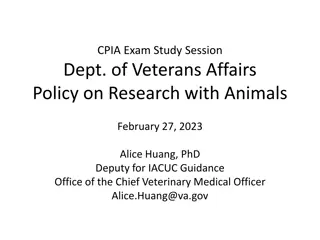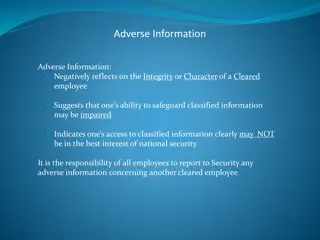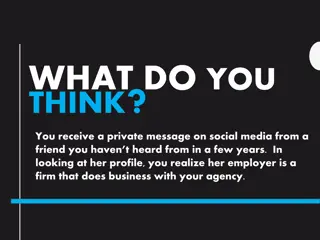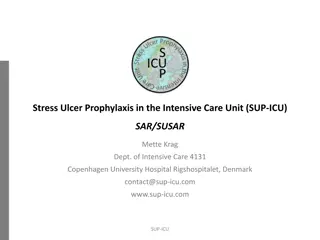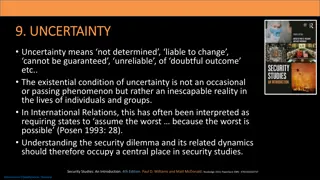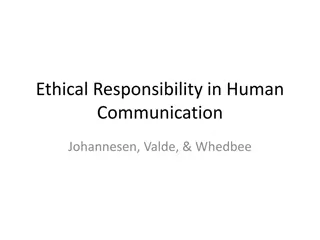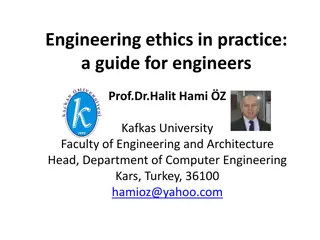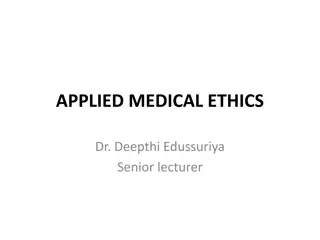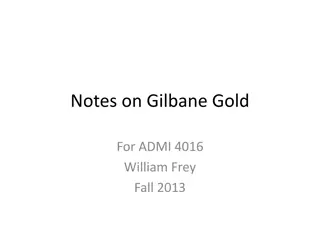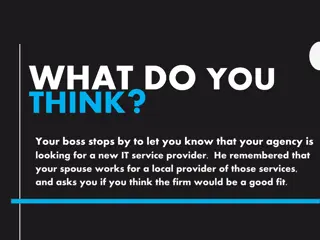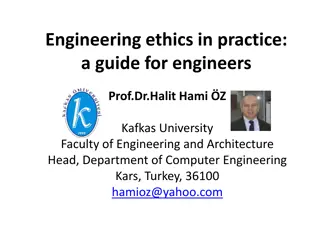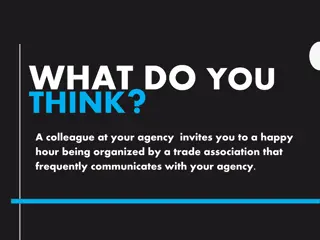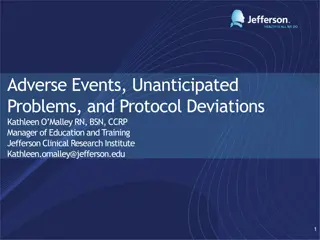Ethical Dilemma in Engineering: Minimizing Adverse Effects
Jean Smith, a self-employed engineering consultant, faces an ethical dilemma as she is pressured by her client to tailor an environmental impact statement to hide negative impacts of a tunnel construction project. She contemplates selective use of data and methodologies to meet client expectations without outright deception, highlighting the challenges of balancing ethical responsibilities in engineering practice.
Download Presentation

Please find below an Image/Link to download the presentation.
The content on the website is provided AS IS for your information and personal use only. It may not be sold, licensed, or shared on other websites without obtaining consent from the author.If you encounter any issues during the download, it is possible that the publisher has removed the file from their server.
You are allowed to download the files provided on this website for personal or commercial use, subject to the condition that they are used lawfully. All files are the property of their respective owners.
The content on the website is provided AS IS for your information and personal use only. It may not be sold, licensed, or shared on other websites without obtaining consent from the author.
E N D
Presentation Transcript
Engineering ethics in practice: a guide for engineers Prof.Dr.Halit Hami Z Kafkas University Faculty of Engineering and Architecture Head, Department of Computer Engineering Kars, Turkey, 36100 hamioz@yahoo.com
I used the Engineering ethics in practice: a guide for engineers book written by The Royal Academy of Engineering for teaching as well as making the ppt presentations about the Engineering Ethics course Prof.Dr.Halit Hami Z Prof.Dr.Halit Hami OZ - Engineering Ethics Course 2
4.2 Minimising and justifying adverse effects Professional engineers should minimise and justify any adverse effect on society or on the natural environment for their own and succeeding generations Scenario Jean Smith is a self-employed engineering consultant. Jean has recently acquired a contract from Construction Towers to produce an environmental impact statement for a project that they have developed. The project is to construct a tunnel beneath a river which divides two halves of a major city. Construction Towers has sold the idea to the city authorities on the basis that a tunnel will relieve significant traffic congestion currently being experienced on one of the main road bridges across the river. Final approval for the project, however, will depend on the results of the environmental impact statement. Prof.Dr.Halit Hami OZ - Engineering Ethics Course 3
4.2 Minimising and justifying adverse effects Jean is aware that she is being employed by Construction Towers, and as such has a responsibility to provide a satisfactory service to her client. Having had a number of informal conversations with members of the client s management team she knows that their expectation is that the report will find no significantly negative environmental impacts associated with the project. She takes this to be a tacit instruction to ensure that the report meets this expectation; furthermore, she knows that such tailoring of reports is common practice amongst her competitors. Prof.Dr.Halit Hami OZ - Engineering Ethics Course 4
4.2 Minimising and justifying adverse effects One way that Jean could ensure the results of the report meet Construction Towers s expectation is to be selective about the date which is used. She knows that there are a number of different ways to construct such a report and a number of different methodologies that could be followed. Unless there are large and obvious environmental issues with the project she believes that she could make the report supportive of the project without committing outright deception. Such results could be achieved, for example, by careful selection of the impacts that will be considered significant, the methods of collecting data, the way the data is analysed, and methods of forecasting future effects. Prof.Dr.Halit Hami OZ - Engineering Ethics Course 5
4.2 Minimising and justifying adverse effects While she does not yet know the outcome of the investigations, Jean has some reasons for thinking that the environmental impact of the project will not be negligible: the proposed entrance to the tunnel is close to a rare grassland habitat, and she has seen evidence from similar projects that suggests the overall effect is likely to be an increase in total traffic and hence an increase in both localised and more widespread pollution. Prof.Dr.Halit Hami OZ - Engineering Ethics Course 6
4.2 Minimising and justifying adverse effects As a further consideration, if Jean report is not supportive of the project she thinks it unlikely that she will get any more work from Construction Towers and also that other clients that she works with will be less likely to employ her in the future. Prof.Dr.Halit Hami OZ - Engineering Ethics Course 7
Dilemma You are Jean Smith, a self-employed engineering consultant. You have been employed to produce an environmental impact statement for a new road tunnel on behalf of the construction company proposing the tunnel. It has been made clear to you that the expectation of your client is that the statement will not find significant environmental problems with the project. However, you are concerned that if you produce a report that meets these expectations, it will not fully represent the adverse effects of the project and could lead to the project proceeding even though its benefits do not outweigh the environmental damage it will cause. How should you go about completing the environmental impact statement? Prof.Dr.Halit Hami OZ - Engineering Ethics Course 8
What should you do? You could proceed with the intention of satisfying your client s request if at first the report is too critical of the project you will adapt the methodology used to make it more favourable. If this does not work you will alter the data you have collected to fit the conclusions. You could conduct the report, adapting the methodology within limits in order to meet the expectations of Construction Towers, but not going so far as using false data or deliberately misleading techniques. Prof.Dr.Halit Hami OZ - Engineering Ethics Course 9
Discussion If you decide before you start that the environmental impact statement will be favourable to the proposed tunnel it is likely that you will have to ignore some of the adverse environmental effects that you could report. The approval process, which is meant to weigh proposed benefits against expected costs, will then not be able to take these effects into account. If the tunnel is approved, it may well be that some of these negative effects are not compensated for by the benefits it provides; at the very least we will not know whether they are outweighed or not. Prof.Dr.Halit Hami OZ - Engineering Ethics Course 10
Discussion Your actions will have prevented the minimisation or justification of any effects on the natural environment, in contravention of the statement of ethical principles. Therefore, option 1 is not an ethically acceptable course of action. Perhaps, then, the second option would be a good compromise. By adapting the methodology of the report to the situation that you find you could do your best to satisfy your client s expectations while at the same time not using false data or any approach that falls outside the bounds of acceptable methodology. Prof.Dr.Halit Hami OZ - Engineering Ethics Course 11
Discussion However, you would perhaps still be left asking yourself questions. How can you determine what these bounds of acceptable methodology are? It is true that such reports are typically constructed in different ways, but at what point does an acceptable difference in methodology become manipulation of the data and the process of the report? You may conclude that any change in methodology that is introduced with the express purpose of delivering a particular result may constitute unacceptable manipulation. Prof.Dr.Halit Hami OZ - Engineering Ethics Course 12
Discussion If this is your conclusion, then perhaps you will decide to set out your methodology before you start collecting data, and then report your findings whether or not they are favourable to the project or not. By trying to construct your report based on accepted best practice, you would be able to fulfil your responsibility to minimise and justify any adverse effect on society or on the natural environment . But how do you determine what best practice would require? Prof.Dr.Halit Hami OZ - Engineering Ethics Course 13
Discussion Furthermore, you know that if your report is unfavourable to the project there is a strong possibility that you will both lose a valuable client and also acquire a reputation in the industry which makes it harder for you to get future work. Construction Towers might even get another consultant to produce a report that is more favourable to the tunnel. At the very least, your actions are unlikely to have a long term effect on the way that environmental impacts are taken into account in such cases, since you are aware that many of your competitors are at least willing to tailor the way they produce such reports to the requirements of their clients. Prof.Dr.Halit Hami OZ - Engineering Ethics Course 14
Discussion Ideally, you could change the way that such reports are typically produced so that it would be accepted by all parties that the results were entirely independent. Perhaps this could be done by introducing a methodology that was certified as an industry standard. But how would you do this, particularly when so many vested interests are at stake? And how should you act in the meantime given that your business depends on keeping your clients happy? Prof.Dr.Halit Hami OZ - Engineering Ethics Course 15
Discussion Legally, you must be very careful that your report does not use false data or parameters or produce a false or misleading result; otherwise you could be committing fraud. It can be fraud not only if you knowingly or recklessly include false data or parameters, but also if you knowingly or recklessly exclude data or parameters which could lead to a different conclusion. You need to bear in mind that in many cases reports are not only being received by your clients, but also by other interested parties, such as the government, the public, or the court. They will often be expecting you to be acting impartially and as an expert. Fraud can result in criminal conviction and fines. Prof.Dr.Halit Hami OZ - Engineering Ethics Course 16
Summary In this case, the best outcome would be for the environmental impact statement to be completed according to a single methodology that has been agreed by all interested parties. This would seem to be the best way of discovering adverse effects of the project and investigating if they were justified. Given that no such a methodology exists, it seems hard for you to bring this result about. If you try to use what you believe to be the best candidate for an industry standard methodology you risk losing your business if the results are not favourable to your client. You could attempt to get such a methodology universally recognised, but how would you do this given the vested interests involved? Prof.Dr.Halit Hami OZ - Engineering Ethics Course 17
Other ethical considerations involved in this case As well as respect for life, law and the public good this case involves considerations of accuracy and rigour, although it might be unclear how to distinguish picking an appropriate methodology for a client from acting with unacceptable bias. Honesty and integritywill come into play with a requirement to reject improper influence, and so will responsible leadership, especially in its requirement for objectivity and truthfulness[link to 5.3]. Prof.Dr.Halit Hami OZ - Engineering Ethics Course 18
4.3 Respecting limited resources Professional engineers should take due account of the limited availability of natural and human resources Scenario BFG Ltd have been contracted by a local authority to undertake restoration work on Russell House, a listed building in England. Russell House is an attractive specialist children s home well-loved by staff and children who, for the duration of the restoration work, have had to be relocated to rather unsatisfactory temporary accommodation. As it is a listed building, materials that need to be replaced must be replaced like-with-like. Most of the timber in the house is sapele hardwood sourced from a single country. Of course, where possible, BFG will retain as much of the original timber as possible. But, as part of the refurbishment the timber will have to be taken out, to get to cables for example, and then put back. As a result of this, some of the timber is likely to break and will need to be replaced like-with-like. Prof.Dr.Halit Hami OZ - Engineering Ethics Course 19
4.3 Respecting limited resources At the same time, however, there are a number of requirements to use sustainable timber. As the restoration is government-funded, BFG are required to comply with the government s timber procurement policy which states that contractors should actively seek to buy timber from legal and sustainable sources. Government contracts are not awarded if contractors cannot guarantee that their timber is legal and, wherever possible, contracts are awarded to those companies who provide timber which is sustainable also. However, many environmental groups argue that these requirements are too lax, and should be more stringent. In particular, the reliability of some of the regulating bodies has been questioned, and the Forest Stewardship Council (FSC) is generally considered to be the most reliable. Prof.Dr.Halit Hami OZ - Engineering Ethics Course 20
4.3 Respecting limited resources Whilst BFG was awarded the contract for Russell House based on their tender to use sustainable timber, there are no further regulations concerning any particular requirements. The government policy does not stipulate, for example, that FSC timber must be used. The local authority has stated, however, that one of the reasons for choosing BFG over other companies was their reputation for having commendable environmental policies. BFG themselves have a policy of only using timber certified as sustainable by the Forest Stewardship Council (FSC). Prof.Dr.Halit Hami OZ - Engineering Ethics Course 21
4.3 Respecting limited resources The company have tried to find a supplier of sapele hardwood sourced from the same country as the original, that was certified as sustainable by the FSC. Unfortunately, this has not been possible and they have found instead a supplier elsewhere in the EU who could provide such wood that was certified as sustainable by the Sustainable Forestry Initiative (SFI). There is also a UK supplier who could provide sapele certified by the FSC, but sourced from a different country. Prof.Dr.Halit Hami OZ - Engineering Ethics Course 22
4.3 Respecting limited resources The staff and management of the children s home have been bringing pressure to bear to complete the project quickly. This is because of the detriment to the welfare of the children from the less suitable temporary accommodation Prof.Dr.Halit Hami OZ - Engineering Ethics Course 23
Dilemma You need to decide whether to go with the supplier who is able to provide SFI-certified wood from the same country as the original wood, or the UK supplier, who is able to provide FSC-certified wood sourced elsewhere. This dilemma involves deciding between two important considerations: taking account of limited natural resources and carefully preserving our collective heritage. Prof.Dr.Halit Hami OZ - Engineering Ethics Course 24
What should you do? You could go with the supplier who is able to provide SFI-certified wood from the same country as the original wood. You could go with the UK supplier, who is able to provide FSC-certified wood sourced from a different country. Prof.Dr.Halit Hami OZ - Engineering Ethics Course 25
Discussion You may think the supplier of wood from the original country presents the most ethically attractive option. Their wood is certified as sustainable, and BFG are not to blame if it turns out not to be. As long as the certificate is there, BFG have done their duty. Although not using FSC timber goes against BFG s usual policy, this is justified in this instance to fulfil the like-with-like condition. The wood is like-with-like and this is important to preserve the heritage of the building - more important than having to consider the mere possibility that the wood might not be sustainable. Prof.Dr.Halit Hami OZ - Engineering Ethics Course 26
Discussion However, there are good reasons for thinking that the UK supplier presents a better option. There is strong reason to suspect that the wood supplied by the other supplier may not come from sustainable sources - the SFI is said not to be as reliable as the FSC and this is probably why BFG have a policy of only using FSC certified timber. The like-with-like condition may not be so stringent and replacing any broken timber with wood of the same species is probably sufficient. Furthermore, the woods are very similar in appearance and properties, and so it is unlikely anyone will notice. Even if the colour of the new timber is slightly different, this may improve with age, and having wood panelling that does not match is not as important as saving endangered habitats Prof.Dr.Halit Hami OZ - Engineering Ethics Course 27
Summary There are two core considerations in this case: the need to preserve the heritage of the building and the need to be sensitive to the natural resources that you use, in particular ensuring that they come from sustainable sources. In order to balance these two considerations you need to use your judgment to determine exactly what each requires in this case. For example, you may decide that SFI certification is not sufficient to make it acceptable to use that wood, and that wood sourced from a different country, but of the appropriate kind is sufficient to preserve the building s heritage. If this were the case, then using wood from the UK supplier is clearly the best option. Prof.Dr.Halit Hami OZ - Engineering Ethics Course 28
Other ethical considerations involved in this case Other considerations that relate to respect for life, law and the public goodwill also be relevant here, in particular the need to act honourably, responsibly and lawfully and uphold the reputation, standing and dignity of the profession. In addition, this case also calls for responsible leadership in being aware of the issues your actions raise for society and the how these bear on the aspirations and concerns of others Prof.Dr.Halit Hami OZ - Engineering Ethics Course 29
4.4 Health and safety Professional engineers should hold paramount the health and safety of others Scenario Kudochem is a multinational chemical company producing chemicals for the agricultural industry. Responsibility for engineering issues at the 11 Kudochem chemical plants in Europe, primarily in the UK, Germany and the Czech Republic lies with Kudochem s European Regional Engineering Director, Sally Proctor. Prof.Dr.Halit Hami OZ - Engineering Ethics Course 30
4.4 Health and safety In the early hours of one morning, Sally receives a telephone call informing her that there has been a serious explosion at one of the plants. There have been some injuries, and damage has been done to property several hundred metres from the plant, but there have been no fatalities. The scale of the damage is huge, and the main site of the chemical plant is almost completely destroyed. Prof.Dr.Halit Hami OZ - Engineering Ethics Course 31
4.4 Health and safety In accordance with company policy, an inquiry team is set up, involving company employees as well as independent consultants. After several weeks, the team discovers two possible causes, both relating to a new ammonia production technique for fertiliser, which has recently been introduced in all of Kudochem s plants. They are unable to determine which of these two possible causes are responsible. Given the presence of the flawed procedure in all of Kudochem s plants, it is imperative that the ultimate cause of the explosion is identified, so that urgent steps can be taken to safeguard against similar accidents at other sites. Prof.Dr.Halit Hami OZ - Engineering Ethics Course 32
4.4 Health and safety The inquiry team is very concerned at their inability to determine the cause of the accident. Without this knowledge, it will be impossible to satisfactorily modify the plants in order to prevent future explosions of this kind. They make a radical recommendation: to call a meeting with several competitor companies who are also using the new procedure in their fertilizer plants, in order to share experiences and research findings. Prof.Dr.Halit Hami OZ - Engineering Ethics Course 33
4.4 Health and safety This would be a significant departure from standard practice, and some senior colleagues with commercial responsibilities have reservations. To call the meeting would entail releasing information about the safety lapse, as well as discussing sensitive commercial information with business rivals. However, it may be the case that other engineers in other companies have encountered problems with the new method for producing ammonia, and could offer help in isolating the problem. Whilst such a course of action may be unusual in this case there are industries where safety critical information is routinely shared amongst competitors Prof.Dr.Halit Hami OZ - Engineering Ethics Course 34
Dilemma You are the European Regional Engineering Director for a multinational chemical company. After an explosion at a chemical plant, you have responsibility for preventing similar accidents at 10 other sites. The inquiry team has been unable to identify the cause with complete accuracy, and they have recommended that you initiate discussions with competitor companies to pool knowledge. This would be unconventional, and would entail significant commercial risk. Prof.Dr.Halit Hami OZ - Engineering Ethics Course 35
What should you do? You could take the advice of the inquiry team, and invite engineers from other chemical companies who are using a similar process to produce ammonia, to come and discuss the accident. You could persevere with the safety inquiry in-house, hire more consultants and attempt to ascertain the precise cause of the accident without involving other companies. You could consider the entire process as too risky, and reconfigure your chemical plants to utilise a different method of ammonia production, perhaps reverting to the older established method. Prof.Dr.Halit Hami OZ - Engineering Ethics Course 36
Discussion In this scenario, the situation could be seen as one in which there is a conflict of interests and duties, such that you are required to balance these conflicting concerns. On the one hand you need to ensure the safety of employees and local residents, and on the other hand you need to maintain the security of commercially sensitive material. In addition, you need to balance the risks with the financial costs of possible remedies Prof.Dr.Halit Hami OZ - Engineering Ethics Course 37
Discussion The Statement of Ethical Principles states that you must hold paramount the health and safety of others. At the same time, though, you need to take into consideration any other obligations you may have including the duty to keep sensitive material secure, and to protect people s jobs by protecting the commercial interests of the company. Prof.Dr.Halit Hami OZ - Engineering Ethics Course 38
Discussion Of course, if a company is acting illegally or irresponsibly, you may have a duty to blow the whistle , and this may defeat any obligation to keep sensitive information secret. However, in this case, there is no indication that the company was acting irresponsibly. As a result, while it may be the case that you have an obligation to protect the safety of others, you have other duties too. Prof.Dr.Halit Hami OZ - Engineering Ethics Course 39
Discussion As such, you could consider the commercial risks of sharing information with your competitors to be too significant. Even if this is not your first response, you could be persuaded by commercial managers of the company that this is true. However, it is not clear that these considerations can outweigh the safety concerns. The principle states that you should hold paramount the health and safety of others. The same procedures are being used in all of Kudochem s plants and, given that the cause hasn t been identified, you need to take seriously the possibility that there could be another explosion. Prof.Dr.Halit Hami OZ - Engineering Ethics Course 40
Discussion Therefore, whichever option you choose, you will need to ensure that you take steps to ensure that there isn t a similar accident in one of the other plants. Therefore, if you decide to keep the enquiry in house and just hire more consultants, whether or not this is acceptable may depend on what other steps you take to prevent accidents at the other plants. If no steps are taken, this option would appear to be ruled out by the principle we are considering. Prof.Dr.Halit Hami OZ - Engineering Ethics Course 41
Discussion Alternatively, you may decide that a remedy will not be found in-house, and that it is not suitable to share information with competitors, and that it is preferable to take the drastic step of replacing the entire process rather than run the risks associated with the other options. This solution at least has the benefit of being associated with predictable costs, timescales and safety levels. Prof.Dr.Halit Hami OZ - Engineering Ethics Course 42
Discussion Finally, it may seem like pooling safety information with other companies is the best way of ensuring the safety of the chemical plants, and of holding paramount the health and safety of others . Not only will you be able to ascertain the cause of the accident and modify your own plants, but your competitors may be able to avoid similar accidents. Prof.Dr.Halit Hami OZ - Engineering Ethics Course 43
Discussion This last point should not be understated. The principle is not just to avoid being the direct cause of harm, but to hold paramount the health and safety of others. As such, if you are able to act in a way that helps other companies to make their plants safer, you should do so. Of course, it is not your main responsibility, and of course your competitors have the primary responsibility of ensuring that their plants are safe. But if there might be problems with their plants, of which they are not aware and about which you could warn them, this does seem to be a further reason in favour of sharing information. Prof.Dr.Halit Hami OZ - Engineering Ethics Course 44
Discussion Furthermore, the practice of sharing information in this manner has precedents in other commercial areas. For example, following the Piper Alpha disaster in the North Sea, offshore oil and gas companies now routinely share safety related information. This may be true, but it is important that in extreme situations such as this you make a thoughtful decision, and reflect on a range of considerations. The safety of employees and residents should take priority, but how this is achieved and how other considerations are compromised will require reflection and careful consideration. Prof.Dr.Halit Hami OZ - Engineering Ethics Course 45
Summary In this case, there does seem to be good reason to share safety information, if at all possible. Of course, where possible this should be done in a way that gives appropriate weight to one s other duties, regarding sensitive information, for example. Ultimately, however, it should be recognised that holding health and safety paramount doesn t just mean ensuring that you are not directly responsible for harms to the public, but that you also have some responsibility to help others improve their health and safety, for example by warning them of dangers they may not be aware of. Prof.Dr.Halit Hami OZ - Engineering Ethics Course 46
Other ethical considerations involved in this case Another consideration that is central to this case is the principle of upholdingthe reputation of engineering. If engineers were perceived to be takingunacceptable risks because they were putting economic considerations and competition before health and safety, this could be very damaging to the engineering profession. On the contrary, the sort of co-operation considered in this case might well enhance the profession s reputation. Prof.Dr.Halit Hami OZ - Engineering Ethics Course 47
Wider applications One of the characteristics of engineering decisions is that they can affect the health and safety of very large number of people. This means that the general public expects engineers to consider the ways in which their activities might put people in danger, and to remove or mitigate those dangers. Prof.Dr.Halit Hami OZ - Engineering Ethics Course 48
Wider applications It is easy to say that the health and safety of employees and the public should take priority, but issues arise in identifying an appropriate level of safety. Engineering activities are rarely 100% safe, and what matters is whether an activity is safe enough , where this is down to the judgement of individuals, society, politicians, scientists or lawyers. Prof.Dr.Halit Hami OZ - Engineering Ethics Course 49
Wider applications This issue crops up most often in engineering in the form of managing a balance between safety and financial cost. How much should you spend in order to avoid death or injury to a member of the public? This decision can depend on many factors, and different answers are given in different areas; rail transport and car transport, for instance. Many aspects of this kind of question are settled by legislation and industry standards, but engineers can easily find themselves having to make decisions at the boundaries. In these situations it is important to be able to think about health, safety and risk in a rational manner, without either feeling totally constrained by financial pressures, or disregarding the practical implications of implementing safety measures. Prof.Dr.Halit Hami OZ - Engineering Ethics Course 50
